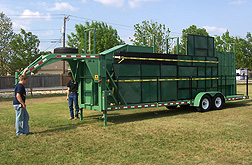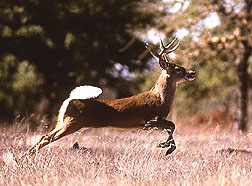
ARS scientists have invented a more human portable
device to restrain deer and other wildlife in order to be able to do field
research such as studying how to control deer ticks and other parasites.
Photo courtesy of Mat Pound, USDA-ARS
|

White-tail deer. Click the image for more
information about it.
|

|
ARS-Developed Apparatus Captures Deer Safely,
Effectively and with Minimal Trauma
By Alfredo
Flores
July 25, 2008 A portable device that allows
researchers to humanely trap deer and other wildlife as part of field studies
to control ticks and other parasites has been developed by an
Agricultural Research Service (ARS)
scientist.
The apparatus, developed by ARS entomologist
Mat
Pound in Kerrville, Texas, effectively restrains wildlife with minimal
trauma to the animal. It will permit wildlife biologists and other researchers
to quickly capture and handle deer, other wild exotic animals and small
livestock such as sheep and goats with minimal stress to the animal.
Pound works at the ARS Tick Research Unit, part of the agency's
Knipling-Bushland
U.S. Livestock Insects Research Laboratory in Kerrville.
Many diseases are transmitted from animals to humans by ectoparasites such
as ticks. Deer and other wildlife can harbor large populations of these
ectoparasites. Yet monitoring and treating significant numbers of
animals—especially wildlife that are not easily captured—to control
these ectoparasites remains difficult.
The new device would greatly assist in ectoparasite control efforts. It
includes an open front that allows an animal to enter, while the rear end
includes a door that opens and closes, effectively containing the animal
without injuring it. The animal is immobilized when it enters, and the device
is designed to gently lift the animal by its trunk so that its legs are
suspended off the ground.
While this device is not yet ready for commercial farmers, it is currently
being used by personnel with the
Cattle Fever Tick
Eradication Program, operated by USDA's
Animal and Plant Health Inspection
Service, to reestablish and maintain eradication of cattle fever ticks and
the potentially fatal Texas cattle fever, also known as bovine babesiosis, from
U.S. cattle herds.
The device was constructed at the Kerrville lab, with the assistance of
students from the Boerne (Texas) High School welding class.
ARS is a scientific research agency of the U.S. Department of Agriculture.